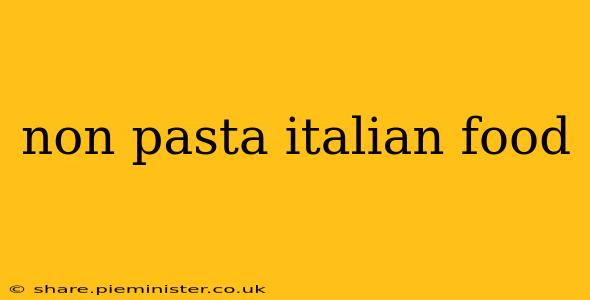Italy, the land of sun-drenched vineyards and picturesque villages, is often synonymous with pasta. While pasta undoubtedly holds a prominent place in Italian culinary tradition, it's far from the only delicious dish this vibrant country offers. This comprehensive guide explores the rich world of non-pasta Italian food, showcasing the diverse regional specialties and ingredients that make Italian cuisine so captivating. Prepare to embark on a culinary journey that transcends the familiar twirls of spaghetti and discovers a wealth of flavourful alternatives.
What are some popular non-pasta Italian dishes?
This is a great question, as it opens the door to the incredible variety beyond pasta. Popular choices vary greatly by region, but some consistent favorites include:
-
Risotto: This creamy rice dish, often incorporating saffron, mushrooms, seafood, or parmesan cheese, offers a comforting and flavorful alternative to pasta. The preparation involves constant stirring to achieve its characteristic creamy texture.
-
Polenta: A staple in northern Italy, polenta is a cornmeal porridge that can be served creamy or grilled, providing a hearty base for various toppings, from cheeses and mushrooms to stews and ragu.
-
Pizza: Arguably Italy's most globally recognized dish, pizza transcends simple fast food. Authentic Neapolitan pizza, with its thin crust and simple toppings, is a culinary masterpiece.
-
Gnocchi: While technically a dumpling, gnocchi are a versatile and popular alternative to pasta, often served with simple tomato sauce, pesto, or creamy cheese sauces. They offer a unique, soft texture.
-
Arancini: These deep-fried rice balls, typically filled with ragu, mozzarella, and peas, are a beloved Sicilian street food and a delicious appetizer or light meal.
What are some Italian main courses that aren't pasta?
Many delicious Italian main courses avoid pasta altogether, focusing on fresh ingredients and regional specialties. Some excellent examples include:
-
Osso Buco: This Milanese specialty features braised veal shanks, slow-cooked until incredibly tender, often served with gremolata (a parsley, lemon zest, and garlic garnish).
-
Saltimbocca: This Roman classic involves veal scallops topped with prosciutto and sage, quickly pan-fried to create a delicate and flavorful dish.
-
Coq au Vin: While French in origin, this wine-braised chicken dish has found a home in Italian cuisine, particularly in regions with strong French influences.
-
Grilled or Roasted meats: From simple grilled chicken or sausages to more elaborate roasted meats like porchetta (stuffed and roasted pork) or porchetta, many Italian meals showcase the quality of fresh, locally sourced meats.
-
Seafood dishes: Italy's extensive coastline provides an abundance of fresh seafood. Expect to find a huge range of options, from simple grilled fish to elaborate seafood stews.
What are some good Italian side dishes that are not pasta?
Side dishes are crucial in completing the Italian meal experience, and many flavorful options exist beyond pasta. Consider these:
-
Roasted vegetables: Simple roasted vegetables like zucchini, bell peppers, eggplant, and asparagus, often seasoned with herbs and olive oil, are a light and healthy complement to many main courses.
-
Insalata Caprese: This classic Italian salad, featuring fresh mozzarella, tomatoes, and basil, is a simple yet elegant side dish, often dressed with olive oil and balsamic vinegar.
-
Minestrone: This hearty vegetable soup, often featuring beans, pasta (small shapes are sometimes included, but it can certainly be made without), and vegetables, is a comforting and flavorful side or light meal on its own.
What are some easy Italian recipes that don't use pasta?
Many delicious Italian recipes are surprisingly easy to prepare. Consider these options for quick and satisfying meals:
-
Bruschetta: Toasted bread topped with fresh tomatoes, garlic, basil, and olive oil—a simple appetizer that can easily become a light meal.
-
Frittata: An Italian omelet, a frittata can be customized with countless ingredients, making it a highly versatile and quick meal.
This exploration showcases just a fraction of the incredible non-pasta dishes that Italy has to offer. Remember that regional variations abound, so exploring different Italian regions’ culinary traditions will unveil even more delightful surprises. So, ditch the pasta preconceptions and discover the true breadth and depth of Italian cuisine.
